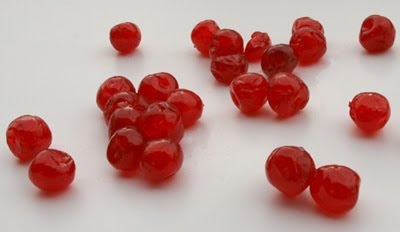image source
Color provides visual information about a food's quality and condition, and influences the perception of its flavor. In nature, color is determined by a food's inherent qualities, indicating types of flavor, and degrees of sweetness, ripeness, or decay. From very early times, however, people have added or changed the natural color in foods: be it for visual appeal, appetite stimulation, symbolism, or to mask defects. Ah, color tricks...
Today, color additives are used in foods for reasons such as:
- to offset color loss due to exposure to light, air, temperature extremes, moisture and storage conditions
- to correct natural variations in color
- to enhance colors that occur naturally
- to provide color to colorless and "fun" foods
image source
Did you know glacé cherries, without the addition of red food coloring, would be an unappetizing beige? Or how about this? Orange carrots weren't always orange. This color is the result of Dutch cultivation in the 17th century, when patriotic growers turned a vegetable which was then purple into the color of the national flag.
Here are some natural dyes that are being used more frequently:
Caramel (caramelized sugar) used in cola
image source
Annato (seeds of the achiote tree) is a reddish orange and can be found added to chocolate ice cream, cheeses, and even some lipsticksCochineal (cochineal insect) red/carmine (what will vegetarians do?)
Food industries are aggressively opposed to the idea of writing "insect based" on the label, but because a subset of the population has food allergies to this bug, beginning in January 2011, you'll be able to find products labeled with "carmine".
image source
Saffron and Turmeric (a cheaper coloring alternative to the first) are used interchangeably in such foods as mustards, rices, and bouillon cubes. image source
There has been considerable concern regarding the carcinogenic properties of colorants. Manufacturers have gone to great lengths to adapt to these concerns, moving away from synthetic colors and towards natural ones. But there's a twist: while consumers perceive natural colorants to be safer, there is no U.S. government regulated definition for the term “natural”. Back in the early 1980s, the Federal Trade Commission deemed that a “natural” product could not contain synthetic or artificial ingredients, and could not be more than minimally processed. But get this- there is no agency that monitors natural coloring additives. (source)Marketing strikes again.
FDA info







